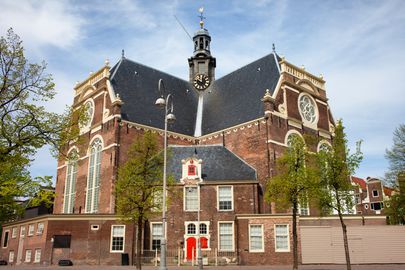

Jordaan is one of the most interesting residential Amsterdam neighborhoods; it borders the Lijnbaansgracht canal to the west, the Prinsengracht to the east, the Brouwersgracht to the north and the Leidsegracht to the south. Rozengracht, which together with a number of other Amsterdam canals, was filled in early in the 20th century when cars and buses became an increasing appearance in the city. It is the main traffic artery that runs more or less down the middle of the neighborhood to the Dam square, terminating at the back of the Royal Palace on the Dam.
Construction of Jordaan commenced in 1612. At first it was called Het Nieuwe Werck (The New Work). The streets and canals traced the original ditches and paths, which explains its unusual diagonal orientation. There are a few legends as to the origin of its current name. Some say it is derived from jardin, the French word for garden, as most of the streets and some of the canals in the Jordaan are named after trees and flowers. Another legend tells that the Prinsengracht canal was once nicknamed Jordaan, after the Jordan river, which in turn lead to the neighborhood lying beyond the canal to be called so too.
The neighborhood was traditionally a leftwing stronghold with a stormy history of riots. On one account, the February Strike of 1941 against the Nazi occupiers started when locals gathered at the Noordermarkt square. For centuries this working-class neighborhood has been riddled with crime and poverty, however during the last couple of decades Jordaan has become one of the most affluent and upscale areas in the Netherlands. The city's trendiest contemporary art galleries, boutiques and antiques stores, cafes and restaurants thrive in this quaint quarter which was once the city's unruliest and toughest. Cor van Hout and Willem Holeeder, Amsterdam’s most infamous criminals who came to prominence in the early 1980s with the abduction of the beer baron Freddy Heineken for ransom, both grew up and spent a lot of time in their beloved Jordaan.
Jordaan is famous for its hofjes or courtyards, which hide peaceful inner gardens, most of which unfortunately are inaccessible as the residents duly keep the entrances to them locked. In the Golden Age, construction of these courtyards was financed by the rich, by way of charity, to house elderly widows. If you're lucky, you may be able to take a peek inside if a resident accidentally left a gate unlatched. The hofjes are officially open to the public during Monument Weekends (usually mid-June and mid-September). During summer months, some are open on Sundays for Classical music recitals. Many of the Jordaan houses feature a stone plaque embedded in the facade above the doors. The plaques display either the profession or are family shields of the original owners. For instance a butcher would have a pig, a tailor - a pair of scissors - carved into stone above their doors. The first of such stone plaques were manufactured in the 16th century, when citizens were ordered to use these, instead of the big wooden gables that obstructed movement in the narrow streets and alleys.
Jordaan has always had a lively folk music tradition. Many Amsterdam crooners in the levenslied (a variation of the schlager) genre were born here and or have in the past or to this day perform in cafes around this area. A monument commemorating some of the neighborhood stars was erected at the corner of Prinsengracht and Elandsgracht. Jordaanfestival, which celebrates the neighborhood's music tradition, is a much celebrated annual event.
The Noordermarkt dates back to 1616 and was originally called Prinsenmarkt, after the Prinsengracht canal which the square borders. The Noorderkerk church dominates the square and was completed in 1623 to serve the rapidly growing Jordaan. The grand Westekerk at the Rozengracht was deemed insufficient and the city fathers decided a second church was to be built at the northern end of the neighborhood. The architect Hendrik de Keyser, who also designed the Zuiderkerk and the Westerkerk, started the construction. After his death in 1621, his son Pieter de Keyser took over and oversaw the completion. The Noorderkerk became the church for the common folk, while the Westerkerk was used mainly by the middle and upper classes. After the church was completed, the square was renamed as the Noordermarkt. Until 1655 it served mainly as the church graveyard. The church is still used by the Dutch Reformed Church to hold its services as well as regularly housing classical music concerts.
In November 1941, the organizers of the February Strike of 1941 against the Nazi discrimination and deportations of the Jews, held their first public protests at the Noordermarkt square. These protests led to quickened and more severe measure by the occupiers. The protest is commemorated by a plaque on the south face of the church.
On Monday mornings the Noordermarkt turns into a small but delightful flea market. Here you'll find various bric-a-brac, ranging from antiques and books to clothes and household kitsch. On Saturdays it’s the organic farmers' market that takes the square over.